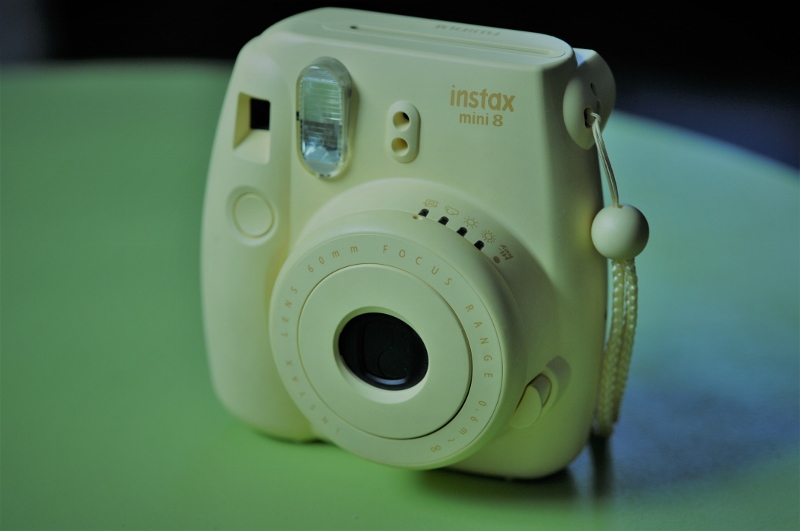Polaroid cameras are back!
The digital age, and particularly the common use of digital cameras and smartphones, has knocked out film cameras completely, for very good reasons. Digital photography is much more accessible, has better quality and lower price. But recently, after many years of being left behind, Polaroid / Instant cameras are back. More and more instant cameras have been launched to the market in the past few years, by various manufacturers (not only Polaroid themselves, but also FujiFilm, for instance), and the use of these cameras is becoming popular again.
The Fujifilm Instax Mini 8 Instant Film Camera - Why Did We Choose It?
One of the most popular Polaroid / instant kid's camera is not made by Polaroid but by Fuji – the FujiFilm Instax Mini 8. When my wife and I were about to buy our 6 years old daughter her first camera, it didn't take us too much time to decide that it was the best option for her. The reasons we liked it were:
- The ability to see the results immediately, and therefore to learn photography from one shot to the other.
- Its "photographer" look and feel – very important for a kid who's making the first steps in photography. What I'm trying to say here is that the FujiFilm Instax Mini 8 is a real tangible camera – not a smartphone, not a sophisticated electronic device with displays and touch screens – its a camera. As a first camera for your kid, I think this is important. It looks and feels different, due to being a Polaroid / Instant camera.
- The pictures are tangible. They aren't just files on your hard disk. And once they are processed, they are present – on the refrigerator door, on a photo collage, in your office. At some point, after taking a few dozen photos and like other toys you probably have at home, the photos are everywhere, and each time your kid bumps into it, it sparks again the motivation to take more photos and thus improve the photography skills. You can never have this effect with digital photos (unless, of course, you print them, but nobody is printing all of their photos these days, right?)

If you already have this camera - click here to learn more about the Instax Mini 8:
Improve Your Instax Mini 8 Experience: 7 Essential Accessories
How to Use the Instax Mini 8 - 5 Important Tips
The Fujifilm Instax Mini 8 Film - Prices, Where to Buy It and More...
PROS
CONS
The FujiFilm Instax Mini 8 is a basic, easy to use, point and shoot camera that takes instant photos and develops them like the good and old Polaroid cameras.
Design
the FujiFilm Instax Mini 8 looks like a combination of a toy and a vintage camera. It is relatively light weight (around 300 gr), made by plastic and available in 7 different colors. Its design is round and playful, and the fact that it's a basic, instant analogue camera, adds the vintage feel to it.
From the kids' perspective, the camera is easy to use. There are only 2 buttons that matter – one next to lens, aimed to turn on the camera, and one for the shutter. The shutter's location, however, could be improved – it's located at the front of the camera, very close to the hand grip, which makes sense, but I think that if it was placed at the upper part of the camera it would be better. The reason is that kids, sometimes, look for the shutter to make sure they put their finger at the right place, and the current location cannot be seen unless they turn the camera around. Another reason is that it's too close to the viewfinder window, so smaller kids may not notice they cover up the window with their finger.
The camera has a built-in flash and a brightness adjustment dial. As opposed to today's cameras there is no display but an old-school viewfinder.
Features
the FujiFilm Instax Mini 8 is a basic camera. All your kid needs to do is point and shoot.
Focus: the camera has no autofocus. The shooting range is 3 to 9 feet (0.6m to 2.7m), so you need to get up close.
Exposure: There are five different exposure levels to choose from, using the brightness adjustment dial, which is located on the lens at the front; Indoors, Night (F12.7), Cloudy (F16), Slightly cloudy (F22), Sunny (F32). Additionally, there’s a Hi-Key mode to shoot photos with extreme levels of brightness and a softer atmosphere.
Flash
The flash has a recycle time of 0.2-6 seconds. Additionally, the flash always fires, so take it into account when shooting indoors.
Shutter
The camera has a fixed shutter speed of 1/60 seconds. Therefore, setting the right exposure is critical. Read more about exposure and Shutter speed in this post: How to Use the Instax Mini 8 - 5 Important Tips.
Film
The FujiFilm Instax Mini 8 uses FujiFilm Instax film that comes in packs of 10 and measures 62 x 46mm. Loading is very easy and intuitive (my 6 years old daughter does it by herself, no parent support is necessary). Click here for a comprehensive review about the Instax Mini 8 film - The Fujifilm Instax Mini 8 Film - Prices, Where to Buy It and More...
Safety
The FujiFilm Instax Mini 8 is safe for kids. The camera is light and easily carried. It also has hand grips for photo taking. In order to protect the camera, don't forget to guide your kid to always use the hand strap. Additionally, a dedicated case can be used to safely store the camera between photography sessions.
Does your kid already have their own camera? check our buyers' guides here:

